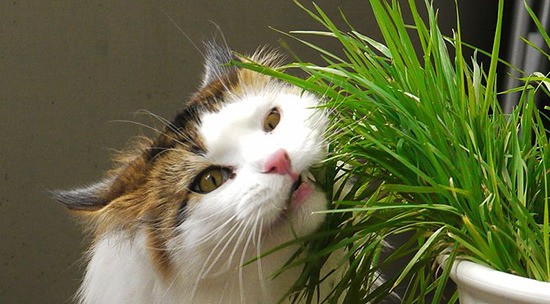Birds
Identifying damage: Droppings; deep triangular peck holes or slashes in larger fruit; smaller fruit eaten whole
Recommended method of control: Exclusion (netting that reaches ground or is gathered around trunk); scare tactics (must be frequently changed); chemical repellants
Cats
Identifying damage: Plants uprooted; feces buried in soil
Recommended method of control: Exclusion (chicken wire at ground level or just below soil through which plants can grow; mulching with stone or pebbles; single or double strands of electric fence at low voltage); resistant plantings; scare tactics (motion-activated sprinklers, dogs)
Deer and elk
Identifying damage: Leaves and twigs ripped from plants leaving a ragged edge; annuals pulled out of the ground; damage to larger trees extending only to about 8 feet; broken branches and torn bark from animal rubbing tree trunk (about 4 feet high)
Recommended method of control: Exclusion (8-foot fence around garden; lower fences effective if slanted outward, double or made of solid material; fencing individual plants); scare tactics; chemical repellants; resistant plants (see wdfw.wa.gov/living/deer.html; however, young and hungry deer will nibble on anything; hunting
Dogs
Identifying damage: Digging up plants; holes in lawn or garden
Recommended method of control: Exclusion (fencing of entire garden, fencing of individual plants, chicken wire at ground level, mulch that is uncomfortable to walk on); resistant plantings (vigorous plants that resist breakage; thorned or prickly bushes but avoid long thorns); important to explore reason for garden damage (dog in need of attention and exercise; digging for prey; trying to escape to mate)
Moles
Identifying damage: Large, volcano-like mole-hills that they push up periodically along their tunnel systems; probably do not intentionally damage plants; plant damage due to voles which often use the mole’s tunnel systems
Recommended method of control: Exclusion (wire mesh bottoms on raised beds and wire mesh baskets around bulbs or roots of plant); scare tactics (watch dog or cat); chemical repellants (castor oil-based repellants effective in Eastern Washington species but not proven on Western Washington species); trapping (must be buried along active runways); poisons (hard, pelletized baits don’t work; newer gel and worm-shaped baits that better mimic natural food sources more promising); hunting or otherwise killing (observing active digging on molehill, stunning and digging down to catch animal)
Mountain beavers
Identifying damage: Damages plant by clipping off stems and branches, leaving 2-inch stubs; destroys more vegetation than it eats; stacks cut vegetation near burrows
Recommended method of control — Exclusion (fencing selected plants; fencing entire yard with rabbit-proof fence; two wire electric fence); trapping
Rabbits
Identifying damage: Twigs on trees and shrubs clipped cleanly at a 45-degree angle; bark on lower stems and branches gnawed away, leaving parallel grooves in the wood
Recommended method of control — Exclusion (chicken wire fence at least two feet high with bottom edge tight against ground or buried a few inches; hardware cloth mesh cylinders; commercial tree wraps); removal of shelter and hiding places; hunting (Rabbits are classified as game animals, therefore, regulations regarding hunting and trapping are in place)
Raccoons
Identifying damage: Attack fruit, nuts and vegetable crops
Recommended method of control: Exclusion (with two-strand electric fence with the first wire about 6 inches from the ground and the second wire 6 inches higher; rodent guards on trunks of fruit trees); trapping
Rats and mice
Identifying damage: Trails through vegetation; gnawing at base of trees/shrubs
Recommended method of control: Removal of wood piles, dense vegetation and rubbish around garden; removal of food sources; baited traps (mouse favorite: mix of peanut butter and rolled oats)
Tree squirrels
Identifying damage: Attack fruit, nuts and vegetable crops; strip, eat bark from trees
Recommended method of control: Exclusion (rodent-guards on trunks of fruit trees); chemical repellants; cage trapping; hunt (though native squirrels are protected by law)
Voles
Identifying damage: Gnawed roots and root crops (small grooves left by the two large front teeth); girdling of tree trunks extending to just above soil line; if other food unavailable, will girdle trees and eat bark
Recommended method of control: Removal of shelter and hiding places; trapping (mousetraps baited with peanut butter or pieces of apple set in their runs); poisons (rodenticides).
Jeanette Stehr-Green and Judy English are Washington State University-certified Clallam County Master Gardeners.


